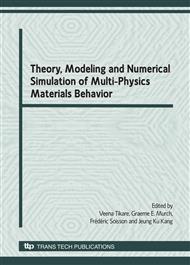p.107
p.113
p.119
p.123
p.129
p.135
p.141
p.151
p.157
Simulation of the Columnar-to-Equiaxed Transition in Alloy Solidification - The Effect of Nucleation Undercooling, Density of Nuclei in Bulk Liquid and Alloy Solidification Range on the Transition
Abstract:
A coupled cellular automaton-finite difference (CA-FD) model is used to simulate the detailed dendritic structure evolution of the columnar-to-equiaxed transition (CET) for Al-Cu alloys during solidification. The effects of material properties (nucleation undercooling, density of nuclei in bulk liquid and alloy solidification range) on the CET are investigated. Simulated results reveal that: (1) equiaxed grains form at an earlier stage with a smaller critical nucleation undercooling; (2) CET is promoted if the density of nuclei in bulk liquid is increased; (3) extending the alloy solidification range promotes the CET. Finally, CET maps corresponding to different alloy concentrations are constructed, illustrating the relationship between processing conditions and the resulting grain structures for alloys with different solidification ranges.
Info:
Periodical:
Pages:
129-134
Citation:
Online since:
April 2008
Authors:
Price:
Сopyright:
© 2008 Trans Tech Publications Ltd. All Rights Reserved
Share:
Citation:


